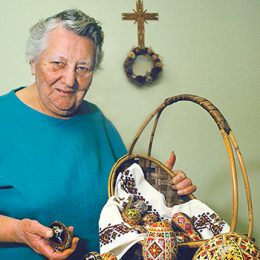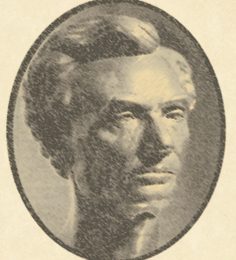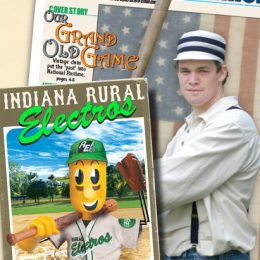
A tombstone at the Lick Creek Cemetery in the Hoosier National Forest lies on the ground. The finger once pointed upward.
(This article appeared in the February 2002 issue of Electric Consumer.)
A winter wind wails through barren tree tops. The rustling branches and creaking limbs break the silence above a small long-abandoned family cemetery just inside the Hoosier National Forest.
Toppled headstones lie partially hidden beneath decaying leaves. Hands carved in the stones that once pointed toward heaven — “home” for the souls whose bodies below have long since turned to dust — now point in a number of directions.
To the casual wanderer, these and the smaller stones that still stand erect among the briars are all that’s left of the once thriving settlement of Lick Creek. But in the surrounding forested acres, the ghosts of Lick Creek are waiting to tell their story. That’s where the homes and churches and farmsteads stood. That’s where the daily lives of the Lick Creek settlers were lived.
Lick Creek is the story of a community racially integrated long before the Civil War. It was settled by free blacks and Quakers in the 1810s and 1820s. They came to Indiana together from North Carolina and settled in the hills of southeastern Orange County. There, they lived and worked side-by-side as equals and at peace in a land torn by the sin of slavery. That alone would make this settlement, virtually abandoned since the late 1800s, significant. “I don’t know how many free black settlements there are in Indiana,” said Angie Krieger, Hoosier National Forest archaeologist. “It’s pretty unique.”
But research into the settlement is also attempting to find documented links to the Underground Railroad, a secretive network of individuals, families and communities that helped runaway slaves in their northward flights to freedom. The Underground Railroad was most active in Indiana from about 1830 until 1865 when slavery was abolished.
The Lick Creek Settlement, some 20 miles north of the Ohio River at Leavenworth, may have played a role. Slavery was legal in the states south of the Ohio River. Runaways crossing the river, often with the assistance of free blacks, probably sought out or were directed to African-American communities or settlements nearby, noted Malia Savarino, assistant grants manager with the Indiana Department of Natural Resources’ Division of Historic Preservation and Archaeology. Early in their journey, she noted, runaways would have been more trusting of free blacks and would have blended more easily into their communities.
The support that Quakers and other white abolitionists gave to the Underground Railroad has long been documented and recognized. Research into the role free blacks and their settlements played in the freedom movement has only recently begun.
Did these folks settle Lick Creek in order to help freedom seekers along the Underground Railroad? The debate has been ongoing. Some historians say too many factors made it too dangerous for free blacks and their families. Federal fugitive slave laws made it illegal to help runaway slaves. Harboring runaways in the settlement, they say, would have invited trouble from the pro-slavery supporters in the area and Kentucky slave hunters who crossed the river in search of runaways and at times kidnapped free blacks and took them south. Some folks with long family ties to the area say they’ve heard stories handed down that claim otherwise.
Scratching the surface
Four Paoli High School students — David Doyle, Chase Kimmel, Josh Rojahn and Mariah Moon — have joined the paper chase to document the connection between Lick Creek and the Underground Railroad. What started as just an idea tossed out during a brainstorming session for the advanced television production class last year has turned into a multi-year project.
“Everything we researched just led to other questions,” said their teacher, Cynthia Webb.
The group’s work seemingly wrapped up last May with a 70-minute documentary video on the Underground Railroad in Orange County. They also put together a live role-playing reenactment of the Underground Railroad. But with the close of the school year, they realized that wasn’t enough. The students told Webb they had more work to do.
That work took Kimmell, Rojahn and Moon (along with Webb and Moon’s parents, Orange County REMC consumers) on a road trip to North Carolina last July. They wanted to know how Jonathan Lindley, a Quaker abolitionist and former legislator, came to lead the group of Quakers and black families from central North Carolina north to Indiana. Some of the African Americans in the group were former slaves whose freedom had been purchased by the Quakers. Others were free citizens seeking to flee the racial persecution of the South.
Webb was amazed at how her students hounded the history. “When I saw them in a musty backroom of a library in the middle of summer going through microfilm and microfiche, I thought, ‘These are real scholars.’ I’m really blessed to have students like this,” she said.
Aided in their research by local historians in the Durham-Raleigh area, they visited the Quaker church attended by Levi Coffin before he moved to Indiana in 1826 and became one of the most well-known Underground Railroad stationmasters. They also made a telling discovery: during larger gatherings of Quakers, the Quaker community that settled in Orange County would have come in contact with members of Levi Coffin’s Quaker community. Establishing a credible link between the two communities in North Carolina could perhaps establish a link between Coffin’s Underground Railroad activity in Indiana and what might have happened at Lick Creek.
Coffin’s home in Fountain City is known as the “Grand Central Station of the Underground Railroad” and is now preserved as a state historic site. As many as 2,000 slaves may have made their way to freedom through the efforts of Coffin and his wife, Catharine.
“There’s a connection somewhere,” Webb said. “If we can verify all these connections, then we feel we can for sure say all this was going on. It’s likely they all were familiar with each other and may have helped each other …. Of course, that’s all speculation on our part. It gives us a reason to go back.”
Going back to North Carolina to continue researching the early relationship between the Lick Creek settlers and Coffin had been a goal of the group. Just last month, they received a $5,500 grant to make a second trip. “We’re just scratching the surface,” said Kimmel, whose family is served electrically by Orange County REMC, “and there’s some stuff we’ll never find out.”
Evidence of other Underground Railroad activity has long been part of Orange County lore. A log house built by a descendant of Jonathan Lindley’s brother in Chambersburg, not far from Lick Creek, had a small pit with a secret trap door in front of the chimney — reportedly to hide slaves. In addition, Paoli and Lick Creek fall right in line with a secondary Underground Railroad route from Evansville to Salem documented in the late 1800s.
“The circumstances were right for the free blacks in the Lick Creek Settlement to aid slaves in the Underground Railroad,” noted Rojahn.
Preserving history
The Paoli students originally got involved in Lick Creek through the Indiana Freedom Trails initiative. Its mission is to locate, identify, verify, protect, preserve and promote the Indiana sites and routes that were part of the Underground Railroad. So far, about 100 volunteers all around the state have joined the grassroots project, conducting research in eight regions.
What makes uncovering the network so difficult today is that the Underground Railroad was secretive even then, especially in Southern Indiana which was settled by pioneers who came mostly from the South. Many people in the area continued their pro-South, pro-slavery beliefs even during the Civil War.
“The willingness to risk their families, their lives, their belongings, their freedom … that is what surprised me the most,” said Jeannie Regan-Dinius of those involved in the movement.
Regan-Dinius, special projects coordinator with the state’s division of historic preservation and archaeology, is facilitating the initiative that is yielding a large amount of new material. One researcher, documenting southeastern Indiana on a grant, produced a 300-page 10-county study that included photographs, maps and text that reads like a Cold War novel. References abound to double-dug cellars, secret tokens, safe-houses, concealed compartments and counter surveillance.
“Down in Southern Indiana, there are hundreds of sites they’re documenting with good documentation,” said Regan-Dinius. “It’s more than just community legend. We have court cases, newspapers … we have diaries and letters we’re finding.”
Along with the secrecy of the organization, the types of homes used in the Underground Railroad make it difficult for researchers today. Regan-Dinius said most of the homes on the Railroad were just average homes of average people, not the kind anyone would think of preserving. “So, they’re easily being lost,” she said.
Savarino noted that researching the contributions of the black communities is even more difficult because they traditionally relied on oral history and less on written memoirs and documents.
Uncovering artifacts
That lack of documented history makes Krieger’s archaeological work for the Hoosier National Forest at Lick Creek even more important. Whether Lick Creek was part of the Underground Railroad, the settlement offers significant historical information in its own right.
“We’re looking at the settlement as a ‘community,’” she said. “We’re investigating it not just for its African-American farms, but for the Quaker farms and the Euro-American farms because it was an integrated community. It was not segregated.”
She said probate records and land deeds dating back to the time prove that the blacks at Lick Creek were not poor. They owned land. Their homes were moderately equipped, and they were fairly well off.
Excavating the ruins, Krieger said, will help them better understand what was going on in pre-Civil War times in Orange County and on pioneer farms in general. The Hoosier National Forest began that work two years ago, creating a summer employment program for students from traditionally black colleges and universities and partnering with the Indiana State Museum and Indiana University-Purdue University at Fort Wayne.
Krieger said she hopes they’ll be able to interpret the site someday for the public with signage and trails. “We only started the archaeological phases two years ago,” she said. “There are thousands of acres in this settlement, and we’ve looked at maybe three. It’s a long long-term project.”
Coming back to Lick Creek
By the mid 1800s, Lick Creek reached its peak. An estimated 200 families lived in the settlement which covered 1,557 acres.
During and after the Civil War, the population there began to sharply decline. A large number of black families sold their land at a loss and moved farther north in September 1862. The mass exodus is a mystery. The war helped create a boom for industry in urban areas which might have lured them away from the hard hilly farmland. Increasing pressure from racist organizations established in the area also may have led to their departure.
Many of the Lick Creek blacks settled in the Noblesville area. Others continued northward in the path of many runaway slaves and settled in Canada, east of Detroit. By the early 1900s, the African Americans were gone from Lick Creek.
Some of the white neighbors purchased the land and continued farming it until they were unable to pay their taxes in the 1930s. That’s when the federal government purchased many tax-delinquent and abandoned farms in Indiana’s southcentral uplands to create the Hoosier National Forest.
In the years since, the forest and brush reclaimed the settlement, yielding the story of Lick Creek only traces at a time: broken pieces of glassware, rusted square-headed nails, foundation rocks. “There are probably other gravesites and cemeteries out here. We just haven’t found them,” Krieger said. “Time has really taken a toll.”
Lick Creek’s history may include a role in the Underground Railroad. It may not. But its ghosts have already taught a group of Paoli High School students and those who have studied the site lessons in diversity.
“They’re definitely an example of how two different people can live together peacefully in such a terrible time period for the African Americans,” said Kimmel. “Just because they were free blacks didn’t mean they could do what they wanted.”
As the archaeological work, crumbling documents and oral histories are pieced together and interpreted, Lick Creek will be resurrected from the forest floor. The reunion will put flesh and bone to the names carved on the toppled headstones that remain and to those names lost in the passage of time. The people of Lick Creek are coming home.
Richard G. Biever is senior editor of Electric Consumer.



